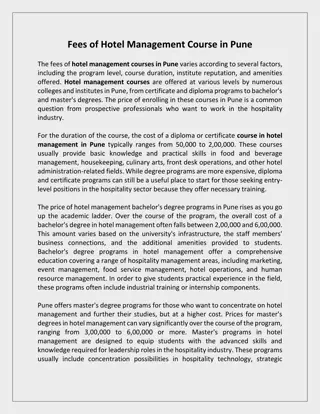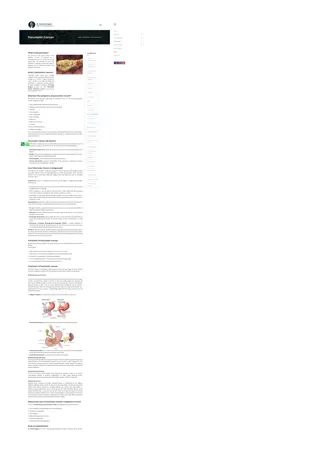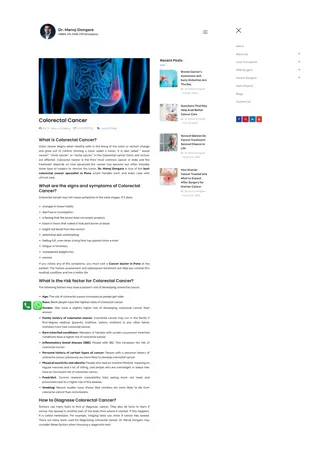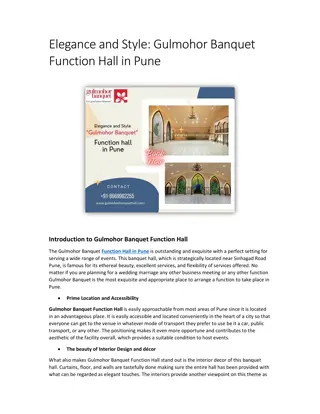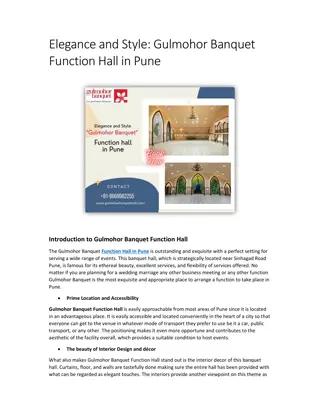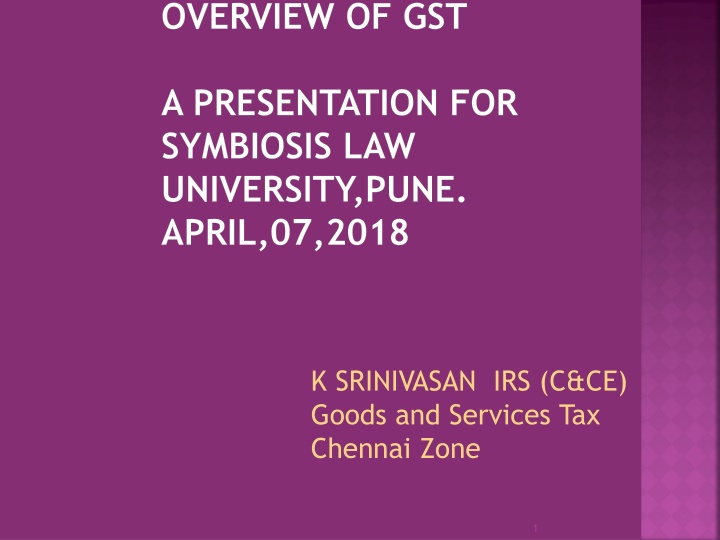
Understanding the Key Features of GST Implementation
Gain insight into the transformative impact of Goods and Services Tax (GST) through its benefits, salient features, and threshold exemptions. Learn how GST simplifies tax processes, enhances competitiveness, and stimulates economic growth. Discover the significance of GST in reshaping India's tax landscape for a brighter future.
Uploaded on | 0 Views
Download Presentation

Please find below an Image/Link to download the presentation.
The content on the website is provided AS IS for your information and personal use only. It may not be sold, licensed, or shared on other websites without obtaining consent from the author. If you encounter any issues during the download, it is possible that the publisher has removed the file from their server.
You are allowed to download the files provided on this website for personal or commercial use, subject to the condition that they are used lawfully. All files are the property of their respective owners.
The content on the website is provided AS IS for your information and personal use only. It may not be sold, licensed, or shared on other websites without obtaining consent from the author.
E N D
Presentation Transcript
OVERVIEW OF GST A PRESENTATION FOR SYMBIOSIS LAW UNIVERSITY,PUNE. APRIL,07,2018 K SRINIVASAN IRS (C&CE) Goods and Services Tax Chennai Zone 1
Introduction Macro Economic GST A Game Changer Fundamentals Salient Features of GST GST and Centre State Financial Relations 2
INTRODUCTION: BENEFITS OF GST The benefits of this transformational tax reform are manifold. The benefits include: A single tax would replace multiple taxes. Set-off of prior-stage taxes would mitigate the ill effects of cascading. Tax burden on goods and services would decrease, benefiting common man. Implementation of GST would make our products competitive in domestic and international markets. It would boost economic activity and create more jobs. The GDP would grow though the estimates in this regard vary. 3
SALIENT FEATURES OF GST The GST would be applicable on the supply of goods or services. It would be a destination based consumption tax. It would be a dual GST with the Centre and States simultaneously levying it on a common tax base. The GST to be levied by the Centre would be called Central GST (CGST) and that to be levied by States would be called State GST (SGST). The GST would apply to all goods other than alcoholic liquor for human consumption and five petroleum products. The GST would apply to all services barring a few already specified. 4
SALIENT FEATURES OF GST.. CONTD. Tobacco and tobacco products would be subject to GST. In addition, the Centre could levy excise duty on these products. The GST would subsume numerous Central and State taxes. The CGST and SGST would be levied at rates to be jointly decided by the Centre and States. The rates would be notified on the recommendations of the GST Council. There would be a floor rate with a small band of rates within which the States may fix the rates for SGST. The exemption list would be common for the Centre and the States. 5
SALIENT FEATURES OF GST.. CONTD. Tax payers with an aggregate turnover in a financial year up to [Rs.20 lakhs] would be exempt from tax. For NE States and Sikkim, the threshold exemption shall be [Rs. 10 lakhs]. Tax payers making inter-State supplies(with the exception of Artisans selling their art-wares up to A Turn Over of 20Lakhs) or paying tax on reverse charge basis shall not be eligible for threshold exemption. Small taxpayers with an aggregate turnover in a financial year up to [Rs.1.5 Crore] shall be eligible for composition levy. Under the scheme, a taxpayer shall pay tax as a percentage(1%) of his turnover during the year without the benefit of input tax credit (ITC). Tax payers making inter-State supplies or paying tax on reverse charge basis shall not be eligible for composition scheme. 6
SALIENT FEATURES OF GST.. CONTD. An Integrated GST (IGST) would be levied and collected by the Centre on inter-State supply of goods and services. Tax payers shall be allowed to take credit of taxes paid on inputs (input tax credit-ITC) and utilize the same for payment of output tax. CGST credit can be used for payment of CGST and SGST credit can be used for payment of SGST. No ITC on account of CGST shall be utilized towards payment of SGST and vice versa. Credit of IGST would be permitted to be utilized for payment of IGST, CGST and SGST in that order. SGST portion of IGST shall be transferred to the destination State where the goods or services are eventually consumed. 7
SALIENT FEATURES OF GST.. CONTD. HSN code shall be used for classifying the goods under the GST regime. Taxpayers whose turnover is above Rs. 1.5 crores but below Rs. 5 crores shall use 2-digit code and the taxpayers whose turnover is Rs. 5 crores and above shall use 4-digit code. Exports shall be treated as zero-rated supply. No tax is payable on exports but ITC related to the Inputs used in the supply for Exports, shall be refunded to exporters. Import of goods/services would be subject to IGST in addition to customs duties. IGST paid shall be available as ITC for further transactions. Laws and procedures for levy and collection of CGST/SGST would be harmonized to the greatest extent possible. 8
GST AND CENTRE-STATE FINANCIAL RELATIONS Currently, the fiscal powers between the Centre and the States are clearly demarcated in the Constitution. The Centre has the powers to levy tax on the manufacture of goods while the States have the powers to levy tax on the sale of goods. In case of inter-State sales, the Centre levies the Central Sales Tax but, the tax is collected and retained by States. As for services, it is the Centre alone that is empowered to levy a tax namely service tax. Introduction of GST would therefore require amendments in the Constitution so as to simultaneously empower the Centre and the States to levy and collect this common tax named GST. 9
Constitutional A BRIEF CONCEPT NOTE Framework ON THE STATEMENT AND PURPOSE OF THE 101STCONSTITUTIONAL AMENDMENT ACT, 2016
A major tax reform like GST calls for an amendment of the Constitution itself. Therefore, the Constitutional Amendment Bill,2014 was introduced in the Lok Sabha which became the One Hundred and First Amendment Act, 2016. The Bill having been passed by Rajya Sabha on 3rd August 2016 became subsequently the above named Act, duly assented by the President of India, on 8th September 2016. Before it could take this shape it had to pass through the Constitutional hurdles of having to secure two third majority in both the houses and the referral to the Rajyasabha Select Committee and a final nod by both the houses.
It was assented by the President on September 8, 2016 and finally got notified on September,17,2016. This is meant to enable the Centre and the States to exercise concurrent jurisdiction in taxation of Goods and Services with the exception of Alcohol for human consumption which continues in the State List.
Five specified Petroleum Products viz petroleum crude, motor spirit, HSD, natural gas and ATF whose Production and sale also continue as exclusive subject matters of levy respectively of the Union and State Lists on which Centre can continue to levy Excise duty plus Surcharge and States can levy State VAT and CST Till such time of commencement of levy on them under GST is notified by the Governments, with the consent of the GST Council.
Tobacco/Tobacco products are subject to a double tax. It figures under both GST and as well as Union List meaning the Centre can levy Union Duties of Excise and surcharge on Tobacco in addition to GST to be levied by the Union and the States.
The Act further amends the Constitution in the 67th year of the Republic of India for the following stated purposes alone The Act contains 20 provisions under it. Provisions 2 to 18 cover the main purposes and the first one being Short title and commencement of the Act. Provision 19 deals with Transition. Provision 20 is concerning powers given under this Act to the President to remove any difficulty arising in the implementation of this Constitutional Amendment Act2016.
For subsuming various Central Indirect Taxes into a Single Central Tax For subsuming various State VAT levies into a Single State tax For introducing a new levy in the name of Integrated Goods and Service Tax to regulate Inter-State Trade and Commerce and stitch together all markets across the country into a common Nation al Market, to integrate the State economies
For conferring concurrent taxing powers on the Centre and the State Legislatures to make laws for the levy and collection of the common National Indirect Tax to be known as Goods and Service Tax. The Taxation is dual but the subject matter of taxation, namely, Goods and Services is common to the Union and the States with the exceptions specified therein.
For creating a special Centre / State Mediatory Body, called GST Council to decide through a consensual approach all matters of this new taxation affecting the interests of the Union and the States The Act was notified on the 17th of September,2016. Therefore its validity being one year, was to expire on the 16th of September,2017 but for the roll out before that. Fortunately, it got rolled out on July,1,2017 for the economic good of India.
Since all other taxes of Centre and State have been subsumed with the exceptions stated above, there would have been practically no enabling provision to levy any indirect taxes by the Centre and States from 16th of September 2017.Hence the urgency to roll out GST by 1stJuly 2017. Fortunately the historic moment came on the midnight of 30th June,2017 to Usher in GST in India.
It must be remembered that the GST Council created under Article 279A vide the 101st Constitutional Amendment Act 2016 is only for a limited purpose of taxation. It shall have no overriding powers to interfere or mediate in any other matter concerning legislatures or to interfere or mediate between Centre and the States/UTs except in the matters of GST. Otherwise, its actions touching upon such other powers of the Centre and States/UTs Shall be construed as ultra vires the Constitution.
The above Amendment Act seeks to amend various Articles and Schedules of the Constitution . It is primarily meant to touch upon Articles 246 and 269 and 279 alone. One to create concurrent jurisdiction (246A (1)). The other to create a new Inter State Tax and its apportionment so as to give the desired shift from the origin based to consumption based tax ( 246A (2) and 269(A). The last to create the GST Council to settle all matters of the new tax through mutual consultations (279A).
But, the Constitution is so interwoven that changes sweep though an array of various other Articles such as 250 Power of Parliament to legislate with respect to any matter in the State List if a Proclamation of Emergency is in operation The words, figures and letters goods and service tax provided under article 246A or shall be inserted. 268 Duties levied by the Union but collected and appropriated by the States The words and such duties of excise on medicinal and toilet preparations shall be omitted
268A Service tax levied by Union and collected and appropriated by the Union and the States Article 268A of the Constitution, as inserted by section Constitution Amendment) Act, 2003 shall be omitted. 269 Taxes levied and collected by the Union but assigned to the States The words, figure and letter except as provided in article 269A shall be inserted 2 of the (Eighty-eighth
270 Taxes levied and distributed between the Union and the States In clause (1), the words, figures and letter articles 268,269 and article 269A shall be substituted After clause (1), the following clauses shall be inserted, namely:- (1A) The tax collected by the Union under clause (1) of article 246A shall also be distributed between the Union and the Sates in the manner provided in clause (2). (1B) The tax levied and collected by the Union under clause (2) of article 246A and article 269A, which has been used for payment of the tax levied by Union under clause (1) of article 246A and the amount apportioned to the Union under clause (1) of article 269A, shall also be distributed between the Union and the States in the manner provided in clause (2).
271 Surcharge on certain duties and taxes for purpose of the Union The words, figures and letter except the goods and services tax under article 246A, shall be inserted. 286 Restrictions as to imposition of tax on the sale or purchase of goods. No law of a state shall impose tax on sale or purchase of goods where such sale or purchase of goods takes place (a) outside the state or (b) in the course of the import of goods into, or export of the goods out of, the territory of India. At both the places above, where the word goods occurs the words goods or services or both shall be substituted
366 Definitions Clause 12 refers to goods including commodities and articles Afetr Clause 12, the following clause shall be inserted namely;- (12A) goods and services tax means any tax on supply of goods, or services or both except taxes on the supply of the alcoholic liquor for human consumption; After Clause (26), the following clauses shall be inserted, namely:- (26A) services means anything other than goods; (26B) state with reference to articles 246A, 268, 269, 269A and article 279A includes a Union territory with Legislatures. all materials,
368 Power of Parliament to amend the Constitution and procedure therefor, to include article 279A. and that does not leave out 244 (2) and 275 (1) read with Schedule VI and 246 read with Schedule VII List I and II. Transitional provision under provision 19 of the Act, for working with the existing Laws until they are repealed or the expiration of one year commencement of this new Act, which ever is earlier. provided from the
Last but not the least is the 20th Provision which deals with the power to President to remove difficulties. Difficulties that may arise giving effect to the provisions of the new Act Difficulty that may arise in relation to transition from the existing to the new Act. Every removal of difficulty intended to be made to be by an order to be tabled before the Parliament as soon as the order is made. No such order shall be made after the expiry of 3 years from the date of Assent.
GUIDING PRINCIPLES Clarity in Tax Laws Taxation Tax laws which are easy to administer Tax laws which are non-adversarial and tax-payer friendly Mechanism Fair dispute resolution mechanism Improving Ease of Doing Business SOURCE MATERIAL Central Excise & Customs Law Service Tax Law State VAT Laws WTO Law
PRESENTATION PLAN Meaning and scope of supply Taxable person Threshold Exemption Composition Scheme Exemption Valuation Input Tax Credit Registration Return Invoice matching Payment of Tax Refund Assessment Audit Demands Tax collected but not paid to Government Recovery of Tax Search, Seizure & Arrest Penalty Prosecution Appeals Advance Rulings Transitional Provisions Other Critical Provisions Model GST Law: Highlights Conclusion 30
MEANING AND SCOPE OF SUPPLY Under GST regime, tax is payable on the supply of goods and/or services. Supply includes All forms of supply made or agreed to be made for a consideration in the course or furtherance of business. Specified supplies made or agreed to be made without a consideration. Importation of service, whether or not for a consideration and whether or not in the course or furtherance of business. Transaction between a principal and agent shall be deemed to be a supply. Supply of any branded service by an aggregator under a brand name shall be deemed to be a supply. 31
TAXABLE PERSON Means a person who is registered or required to be registered under Schedule III. Liability to pay tax arises only when the taxable person crosses the exemption threshold i.e. [Rs. 20 lakhs.] The Central / State Government and local authorities are regarded as taxable person. Persons who are not regarded as taxable persons under GST: an agriculturist an employee providing services to his employer person dealing with goods and/or services that are not liable to tax under the Act person receiving services of value not exceeding Rs . in a year for personal use 32
THRESHOLD EXEMPTION Taxpayers with an aggregate turnover up to [Rs. 20 lakhs] in a FY shall be exempt from tax. Aggregate turnover shall be computed on all India basis. For NE States and Sikkim, the exemption threshold shall be [Rs. 10 lakhs]. All taxpayers eligible for threshold exemption will have the option of paying tax with input tax credit (ITC) benefits. Tax payers making inter-State supplies or paying tax on reverse charge basis shall not be eligible for threshold exemption. 33
COMPOSITION SCHEME Small taxpayers with an aggregate turnover up to [Rs.1.5 Crore] in a FY shall be eligible for composition levy. Under the scheme, a taxpayer shall pay tax as a percentage of his turnover during the year without the benefit of ITC. The floor rate of tax for CGST and SGST shall not be less than [1% and the peak rate of CGST AND SGST shall not exceed 20 % each]. A tax payer opting for composition levy shall not collect any tax from his customers. Eligible taxpayers shall have the option of paying tax with ITC benefits. Tax payers making inter-State supplies or paying tax on reverse charge basis shall not be eligible for composition scheme. 34
EXEMPTION On the recommendation of the Council, the Central/State Govt. may, by notification, exempt specified goods and/or services from payment of CGST/SGST. Exemptions are of two types: General and Adhoc. General exemptions are universal in nature and are issued in public interest. Adhoc exemptions are issued in public interest to deal with circumstances of an exceptional nature. An explanation can be inserted in the notification within one year of its issue, clarifying the intent and scope. Notification shall be published in the official gazette and made available on the official website. 35
VALUATION Valuation to be done on the basis of transaction value. Transaction value is the price actually paid or payable for the goods and/or services. Transaction value shall, inter-alia, include: any taxes, duties, fees and charges levied under any statute other than CGST/SGST/IGST Act. incidental expenses such as commission, packing etc. charged by the supplier to the recipient of supply. royalties and licence fees related to the supply of goods and/or services. subsidies provided in any form or manner except subsidies provided by the Government. any discount or incentive that may be allowed after supply has been effected. 36
VALUATION.. Contd. Transaction value shall not include trade discounts allowed before or at the time of supply. Transaction value shall not include post supply discount which is given as per the agreement and is known at or before the time of supply. Where the value cannot be determined on the basis of transaction value, the same shall be determined in accordance with the Valuation Rules. Determination of value by comparison Computation method. Cost of production plus an amount towards profit and general expenses. Residual method using reasonable means consistent with the principles and general provisions of valuation rules. 37
INPUT TAX CREDIT(ITC) ITC is available for business purposes and in respect of all taxable supplies. ITC is available on all goods other than goods and/or services in the negative list. Negative list comprises, inter alia, motor vehicles (except when they are used for certain purposes) goods and services provided in relation to food and beverages, outdoor catering, beauty treatment etc. goods and / or services on which tax has been paid under composition scheme Full ITC shall be allowed on capital goods on its receipt. 38
INPUT TAX CREDIT.. Contd. The taxable person shall take credit and may utilize the same for payment of output tax. Unutilized credit can be carried forward or can be claimed as refund in certain situations. Condition for availing of ITC by taxable person: he is in possession of a tax invoice he has received the goods and/or services the tax charged in respect of the supply has been paid to Government he has furnished the return ITC cannot be availed on invoices which are more than one year old. 39
INPUT TAX CREDIT.. CONTD. Manner of utilization of credit ITC on account of CGST shall first be utilized towards payment of CGST; the amount remaining, if any shall be utilized towards payment of IGST ITC on account of SGST shall first be utilized towards payment of SGST; the amount remaining, if any shall be utilized towards payment of IGST. No ITC on account of CGST shall be utilized towards payment of SGST and vice versa. ITC on account of IGST shall first be utilized towards payment of IGST; the amount remaining, if any shall be utilized towards payment of CGST and SGST, in that order. 40
REGISTRATION Liability to be registered Every person who is registered or who holds a license under an earlier law Every person whose turnover in a year exceeds Rs. [18 lakhs] Liability to be registered irrespective of threshold Persons making inter-State taxable supply Persons required to pay tax under reverse charge Casual and non-resident taxable persons E-Commerce operator Persons who supply goods through e-commerce operator An aggregator who supplies services under his brand name Persons who supply goods and/or services on behalf of a registered taxable person. Input Service Distributor Persons required to deduct tax at source 41
REGISTRATION.. CONTD. A person, though not liable to be registered, may take registration voluntarily Registration to be granted State-wise. A person having multiple business verticals in a State may obtain separate registration UN agencies, Multilateral Organizations, Embassies etc. shall be granted a Unique Identity Number instead of registration Registration shall be approved by both the Central and State authorities. Registration shall be deemed to have been granted if no deficiency is communicated to the applicant within the prescribed period Cancellation of registration under CGST Act means a cancellation of registration under SGST Act and vice-versa 42
RETURN Taxpayers shall file monthly returns. Return to be filed within 20 days after the end of tax period Composition taxpayers shall file quarterly returns ITC shall be provisionally allowed on filing of return Short-filing of return is allowed, but returns filed without payment of full tax shall not be treated as a valid return for allowing ITC in respect of supplies made by taxable person Annual return to be filed on or before 31st December following the end of the financial year Audited statement of accounts and reconciliation statement to be submitted along with the Annual Return by certain taxable persons 43
INVOICE MATCHING After filing of return by the taxable person, his inward supplies and/or debit notes shall be matched with the corresponding outward supplies and/or debit notes declared by the supplier in his tax return. In case of matching, the ITC claimed by the taxable person shall be finally accepted and he shall be informed. In case of mis-match, the discrepancy shall be notified to the taxable person and his supplier. Where the supplier does not rectify the discrepancy in his return, the amount to the extent of discrepancy shall be added to the output tax liability of the taxable person. 44
INVOICE MATCHING..Contd. Likewise, the reduction in tax liability due to issue of a credit note by the supplier shall be matched with the reduction in ITC claimed by the recipient in his return. In case of matching, such reduction in the tax liability shall be finally accepted and communicated to the supplier. In case of mis-match, the discrepancy shall be notified to the supplier and the recipient. Where the recipient does not rectify the discrepancy and reduce his ITC claim in his return, the amount to the extent of discrepancy shall be added to the output tax liability of the supplier. A taxable person can reclaim the ITC reversed only after the concerned supplier furnishes the details of invoice and/or debit note in his return. 45
PAYMENT OF TAX Every deposit made by a taxable person shall be credited to the electronic cash ledger of such person ITC as self assessed in the return of a taxable person shall be credited to his electronic credit ledger Payment of tax is made by way of the debit in the electronic cash or credit ledger Taxable person shall discharge his tax and other dues in the following order Self-assessed tax, and other dues related to returns of previous tax periods; Self-assessed tax, and other dues related to returns of current tax period; and any other amount payable under the Act or rules made there under including the demand determined under section 51. 46
REFUNDS Refund can be claimed within 2 years from the relevant date. Refund of ITC allowed in case of exports or where the credit accumulation is on account of inverted duty structure. Refund shall be granted within 90 days from the date of receipt of application. In case of refund claim on account of exports, 90% of the claim can be given immediately on a provisional basis. Applicant shall produce documentary evidence that he has not passed on the incidence of tax on to any other person. No need to furnish such evidence if the refund claim is less than Rs. 5 lakhs. Self-certification would suffice. Interest payable after 3 months from the date of receipt of application till the date of refund. Refund of ITC not allowed where the export goods are subject to duty. 47
ASSESSMENT Taxable person shall himself assess the taxes payable Taxable person may request for provisional assessment in cases where he is unable to determine the value or rate of tax Taxable person will have to furnish bond and security for availing this facility. Provisional assessment is to be finalized within 6 months After final assessment, the taxable person shall be liable to pay additional tax or may claim refund, as case may be 48
AUDIT Audit can be conducted at the place of business of the taxable person or at the office of the tax authorities. Taxable person shall be informed sufficiently in advance, prior to the conduct of audit. Audit shall be carried out in a transparent manner. Audit to be completed within 3 months, extendable by a further period of 6 months. On conclusion of audit, the proper officer shall without delay notify the taxable person of the findings, the taxable person s rights and obligations and reasons for the findings. 49
DEMANDS Adjudication order shall be issued within 3 years of filing of annual return in normal cases The time limit is 5 years (from filing of annual return) in fraud/suppression cases. No separate time lines for issue of SCN and adjudication order. Provisions for settlement of cases at every stage, right from audit/investigation to the stage of passing of adjudication order and even thereafter. No/Minimal penalty if the tax and interest is paid at the stage of audit/investigation. The officer shall in his order set out the relevant facts and the basis of his decision. The amount of tax, interest and penalty demanded in the order shall not be in excess of the amount specified in the notice. No demand shall be confirmed on grounds other than the grounds specified in the notice. 50










